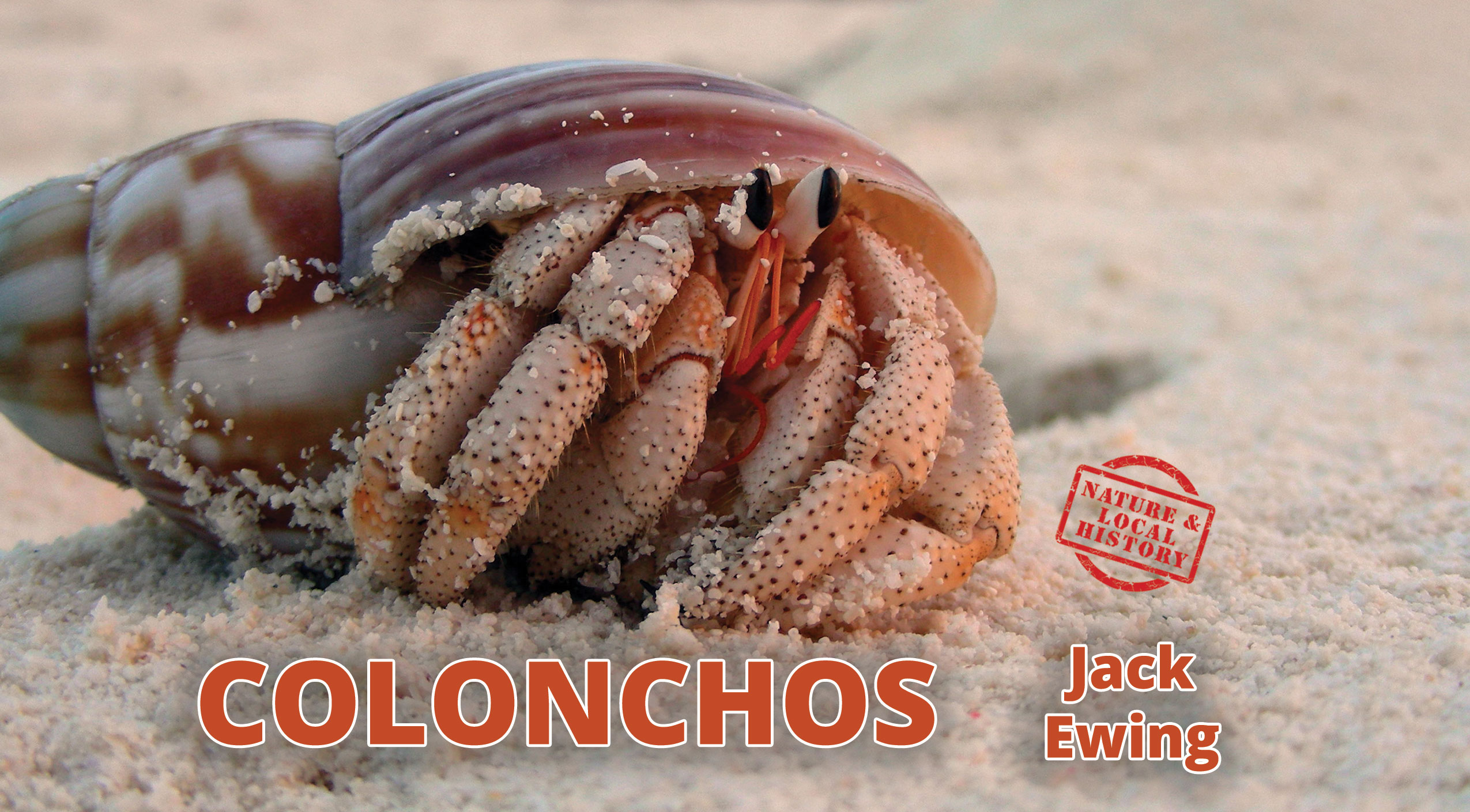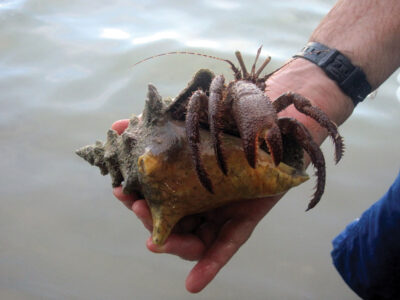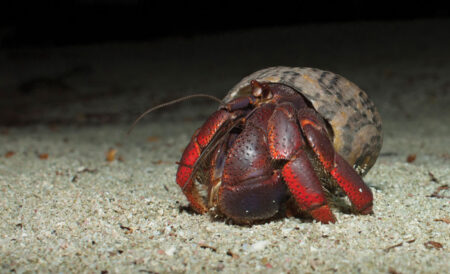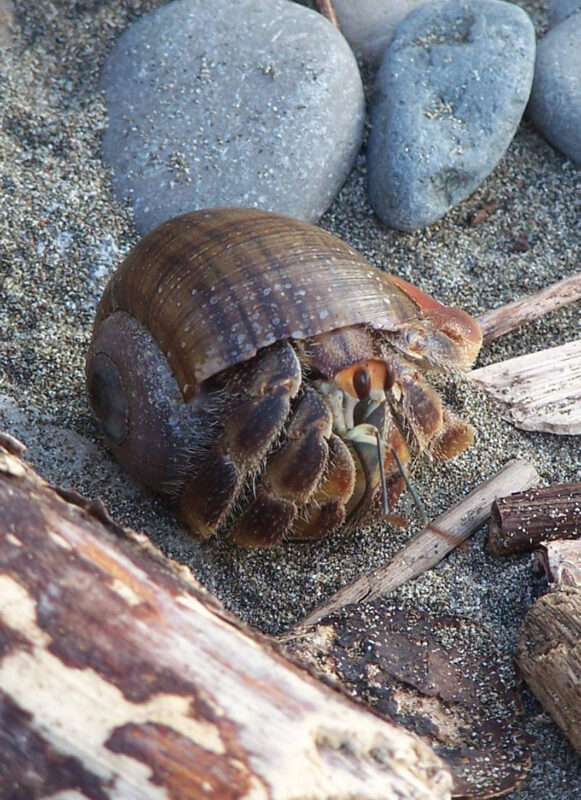Colonchos

THE SHELL GAME
“Hey Eduardo! Look. Somebody cut this coconut husk open, and it is full of all these little crabs. Boy, do they stink”.
 “It’s not the crabs that stink”, he laughed. “It’s the rotten coconut. They love it. When I need fish bait, I just look for a coconut husk that’s been cut open. If there’s still any rotting coconut meat left, it’s sure to be full of colonchos. See…” He stuck his hand through a hole in the coconut and pulled out one of the colonchos, which I later learned are called “hermit crabs” in English. Eduardo held tight to the shell, a little smaller than a ping pong ball, grabbed the crab’s head and pincher, and pulled steadily until the little invertebrate came free of its protective home, which Eduardo dropped on the ground. The head looked like a crab and the back part more like a fat worm. “Fish love them”, he said with a smile. Reaching into his bag, Eduardo pulled out a hand reel with some light fishing line and a small hook which he stuck through the crab and tossed it into the estuary. It didn’t take long before he had a nibble. After several tries, he hooked a fish he called a machaca. In half an hour he had four. They weren’t much bigger than his hand, but he took them home anyway. “My wife knows how to fry them up real tasty”.
“It’s not the crabs that stink”, he laughed. “It’s the rotten coconut. They love it. When I need fish bait, I just look for a coconut husk that’s been cut open. If there’s still any rotting coconut meat left, it’s sure to be full of colonchos. See…” He stuck his hand through a hole in the coconut and pulled out one of the colonchos, which I later learned are called “hermit crabs” in English. Eduardo held tight to the shell, a little smaller than a ping pong ball, grabbed the crab’s head and pincher, and pulled steadily until the little invertebrate came free of its protective home, which Eduardo dropped on the ground. The head looked like a crab and the back part more like a fat worm. “Fish love them”, he said with a smile. Reaching into his bag, Eduardo pulled out a hand reel with some light fishing line and a small hook which he stuck through the crab and tossed it into the estuary. It didn’t take long before he had a nibble. After several tries, he hooked a fish he called a machaca. In half an hour he had four. They weren’t much bigger than his hand, but he took them home anyway. “My wife knows how to fry them up real tasty”.
 I once heard a story about a delightful little beach which we will call “Pretty Beach”, and which was lined with coconut palms and Indian almond trees. Away from the hot sand, in the shade of the trees were lots and lots of hermit crabs. One day a stranger came to Pretty Beach and offered the people who lived there two hundred colones for each hermit crab they brought him. The adults had other, better paying, work to do elsewhere, but the kids ran right out and started gathering up colonchos for the stranger. Good to his word he paid 200 colones for each crab. It was easy to find the crabs, and it only took five of them to make a thousand colones, enough for a soda or a bag of chips. The buyer left with several hundred crabs and said he would be back in a week. When asked what he was going to do with so many hermit crabs, he smiled and said he was going to sell them as pets. “Who would buy a coloncho for a pet”, they asked incredulously, and he asserted that in North America lots of people would pay good money for them, give them names, and paint fancy designs on their shells. The kids from Pretty Beach all thought that was the craziest thing they’d ever heard, but they kept on bringing him crabs, and he kept on paying for them. Before long it became harder and harder to find hermit crabs until one day the stranger showed up and the kids had less than a dozen for sale. That was the last time they saw him. It wasn’t long before the beach started to smell like rotten coconuts and dead fish.
I once heard a story about a delightful little beach which we will call “Pretty Beach”, and which was lined with coconut palms and Indian almond trees. Away from the hot sand, in the shade of the trees were lots and lots of hermit crabs. One day a stranger came to Pretty Beach and offered the people who lived there two hundred colones for each hermit crab they brought him. The adults had other, better paying, work to do elsewhere, but the kids ran right out and started gathering up colonchos for the stranger. Good to his word he paid 200 colones for each crab. It was easy to find the crabs, and it only took five of them to make a thousand colones, enough for a soda or a bag of chips. The buyer left with several hundred crabs and said he would be back in a week. When asked what he was going to do with so many hermit crabs, he smiled and said he was going to sell them as pets. “Who would buy a coloncho for a pet”, they asked incredulously, and he asserted that in North America lots of people would pay good money for them, give them names, and paint fancy designs on their shells. The kids from Pretty Beach all thought that was the craziest thing they’d ever heard, but they kept on bringing him crabs, and he kept on paying for them. Before long it became harder and harder to find hermit crabs until one day the stranger showed up and the kids had less than a dozen for sale. That was the last time they saw him. It wasn’t long before the beach started to smell like rotten coconuts and dead fish.
Before the arrival of the stranger, the hermit crabs had eaten almost any kind of organic matter and kept the beach clean, but now they were all gone, and the bad smell lingered. There was no more fish bait either. The people thought that before long the ocean would bring more hermit crabs, but that didn’t happen either. Pretty Beach wasn’t the same ever again.
 Why didn’t newly hatched hermit crabs colonize Pretty Beach? Because there weren’t any shells for them. The crabs hatch in the ocean and go through several growth stages, but once the larvae become mature hermit crabs they come out of the sea onto the beach and look for a shell in which to live, usually one that used to belong to another hermit crab. The crabs that don´t find shells fall prey to one of many hungry predators. It is important that the shell be the right size, and as the crab grows it must acquire new and bigger shells. Let’s say a hermit crab is feeling a little tight in its shell and decides to get a new one. It starts looking around for a bigger one. Finally, it finds one and tries it on for size, but it happens to be a little bit too big. You would imagine that the crab would keep looking, but that’s not what it does. Instead, it waits beside the bigger shell until a second crab comes along looking for a new shell. Number two tries on the empty shell, but as luck would have it, the new shell is a tight fit and won’t work for it either. So, both crabs wait beside the empty shell until a third one comes along. This goes on, and the crabs form a line according to size until finally one comes along that fits the empty shell perfectly. It moves in and abandons its old shell which the others then start trying on for size. With lots of good fortune everyone ends up with just the right shell, and there is one empty shell left for some other lucky crab. But sometimes the struggle for just the right shell gets violent and can even end up with the death of one or more crabs. The shells are the key to the life of a hermit crab. Please don’t take them away from the beach, and even more important, please, please, please don’t ever buy a pet hermit crab.
Why didn’t newly hatched hermit crabs colonize Pretty Beach? Because there weren’t any shells for them. The crabs hatch in the ocean and go through several growth stages, but once the larvae become mature hermit crabs they come out of the sea onto the beach and look for a shell in which to live, usually one that used to belong to another hermit crab. The crabs that don´t find shells fall prey to one of many hungry predators. It is important that the shell be the right size, and as the crab grows it must acquire new and bigger shells. Let’s say a hermit crab is feeling a little tight in its shell and decides to get a new one. It starts looking around for a bigger one. Finally, it finds one and tries it on for size, but it happens to be a little bit too big. You would imagine that the crab would keep looking, but that’s not what it does. Instead, it waits beside the bigger shell until a second crab comes along looking for a new shell. Number two tries on the empty shell, but as luck would have it, the new shell is a tight fit and won’t work for it either. So, both crabs wait beside the empty shell until a third one comes along. This goes on, and the crabs form a line according to size until finally one comes along that fits the empty shell perfectly. It moves in and abandons its old shell which the others then start trying on for size. With lots of good fortune everyone ends up with just the right shell, and there is one empty shell left for some other lucky crab. But sometimes the struggle for just the right shell gets violent and can even end up with the death of one or more crabs. The shells are the key to the life of a hermit crab. Please don’t take them away from the beach, and even more important, please, please, please don’t ever buy a pet hermit crab.
Unfortunately, Pretty Beach is doomed to be lined with stinky coconuts for ever and ever. All the shells have gone north.
Jack Ewing was born and educated in Colorado. In 1970 he and his wife Diane moved to the jungles of Costa Rica where they raised two children, Natalie and Chris. A newfound fascination with the rainforest was responsible for his transformation from cattle rancher into environmentalist and naturalist. His many years of living in the rainforest have rendered a multitude of personal experiences, many of which are recounted in his published collection of essays, Monkeys are Made of Chocolate. His latest book is, Where Jaguars & Tapirs Once Roamed: Ever-evolving Costa Rica.
